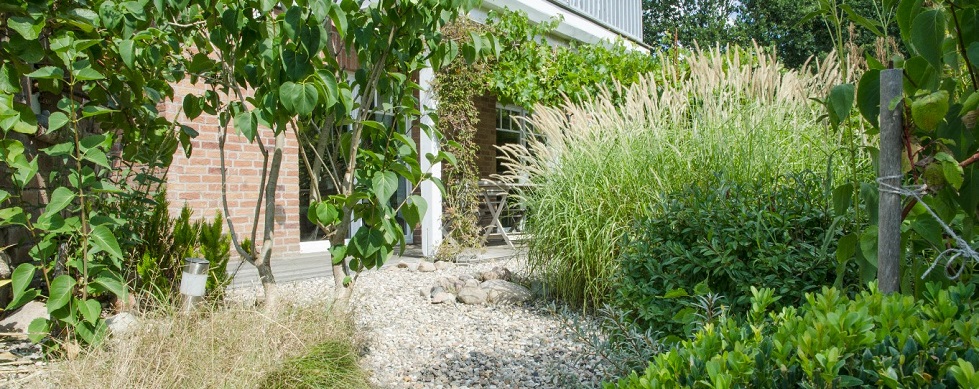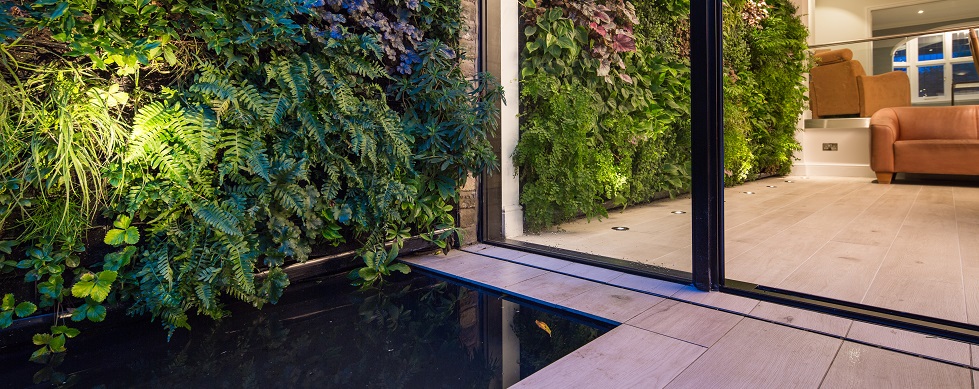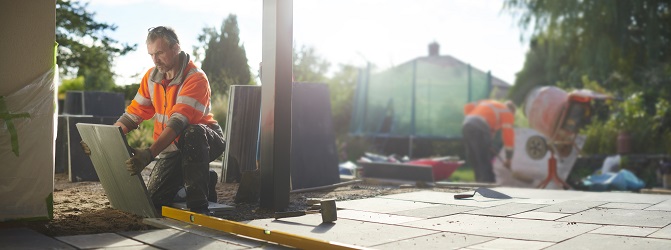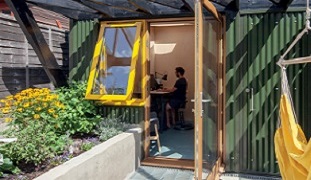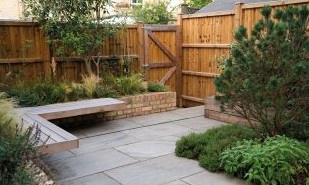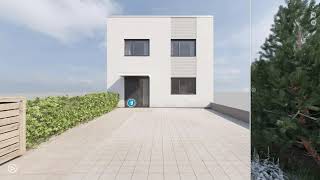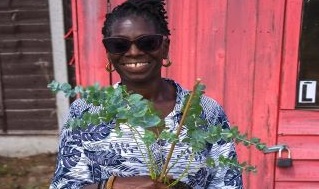Sustainable Garden Design; Nature Sets the New Standard
There was a time, long ago, when you couldn’t walk far across Britain without tripping over a beaver dam. Sadly, sometime around the 16th century, the last of the Eurasian beavers to live wildly in Britain were hunted to extinction.
Today though, against a complex background of global warming and climate change, the reintroduction of these creatures to the countryside is teaching landscapers and gardeners valuable lessons about water sustainability – even in the most heavily urbanised areas.
A beaver dam on a river or stream slows down water velocity, preventing overwhelming quantities from causing damage downstream. It filters out certain nitrates and phosphates, improving water quality. Beavers use the dam as a home, an amenity for storing food. And all of this activity creates a knock-on effect, benefitting other natural systems by increasing surrounding water surface area.
In fact, it’s the perfect representation of the four principles of a SuDS (Sustainable Drainage System) – quantity, quality, amenity and biodiversity. These are key to sustainable garden design – and a way landscapers and contractors can not only help mitigate against the effects of climate change, but create attractive, rewarding outdoors spaces for their customers.
The changing landscape
A few decades ago, many thought global warming would simply mean more sunbathing in Blackpool. The reality is the ‘feast or famine’ weather patterns we’re getting used to now. While one minute we’re baking in a prolonged dry period of ‘record high temperatures’, the next we’re watching news footage of floodwater cascading down the steps of the London Underground. Now, reports suggest that drought will be such a problem in the south east of England, there’ll be water shortages. Really? How can flooding cause a shortage of water?
The fact is, we’re expanding our towns and cities. Building on greenfield sites to accommodate new homes. Paving over front gardens, ready to plug in a shiny new electric car. This of course, creates more hard, impermeable surfaces and means fewer natural, grassy or wooded permeable surfaces. Water moves quicker on non-permeable surfaces. A quick scan of the illustration below and you’ll see the dramatic differences in the way it behaves in natural versus urban environments.
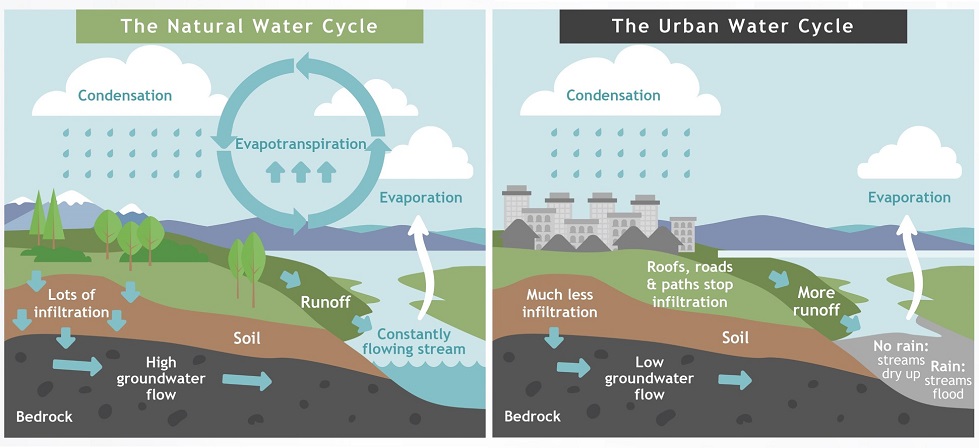
Water stored underground lasts for eons. Water that runs off into surface water simply evaporates away.
These factors are of such concern that the Department for Environment, Food and Rural Affairs (DEFRA) has recommended updates to the non-statutory technical standards for SuDS*. DEFRA now has six key standards to consider when designing water management systems:
- Runoff destinations
- Everyday rainfall
- Extreme rainfall
- Water quality
- Amenity
- Biodiversity.
Obviously, we could fill this whole article with discussion on all six standards, but the one we can move on most effectively in the short term is Standard 1 – runoff destinations.
This states that, ideally, surface water runoff should be used for non-drinkable uses such as rainwater harvesting – this can then be employed for anything from watering the garden to flushing toilets. If that’s not feasible, opportunities should be maximised for water to infiltrate the ground. If none of the above is feasible, then a piped surface water drainage system is recommended or, as a last resort, a combined sewer – this last option will, of course, require permission.
All very well, but when homeowners are thinking about designing their outdoor spaces, the last thing on their mind is drainage. Many don’t realise that in some local authorities, if you’re turning more than 5m² of your front garden from permeable to non-permeable, it’s time to get the planners in**.
And as DEFRA guidelines often change from the nice-to-haves to the have-to-haves, there could be interesting times ahead.
Landscapers can lead the charge
But it’s not all doom and gloom. Managing water sustainably and responsibility does not have to come at the cost of abandoning style or compliance.
Managing quantity is made possible by water channelling systems that run around buildings. During a deluge, this allows water to disperse in a more even manner – and in a variety of ways other than just straight off the downpipe and into an overwhelmed sewer system. This channelling can be visibly stylish (think designer driveways), or fitted in such a way as to be practically invisible.
For quality, again, we need to prevent runoff water going straight into the sewers, and this can be done with soakaway crate systems that let rainwater infiltrate the ground. Amenity means looking into rainwater harvesting solutions to store rainwater for prolonged dry periods that could follow or, instead (or as well as), creating water features that bring life to outdoor spaces.
If all the above has been put into place, biodiversity will naturally follow, but consideration into planting can also be driven by the changing climate. Some countries in northern Europe are now able to grow plants previously only able to thrive in the drier south. (Who, two decades ago, would have put money on British wine winning global awards?)
So while climate change is affecting our weather in ways we can’t control, SuDS is helping us manage water in a way we can – to rethink our attitude to it, and value it a precious resource. Perhaps it’s time to look upon our customers’ outdoor spaces as an asset to help them mitigate against the effects of a changing climate and encourage biodiversity. And allow landscapers and contractors to turn lessons from animals in the wild, into opportunities to help our urban areas to flourish.
- Visit the ACO page for Garden Designers and Landscapers
- *DEFRA Recommendations to Update Non-Statutory Technical Standards for Sustainable Drainage Systems (SuDS) Final Report, February 2021
- **planningportal.co.uk
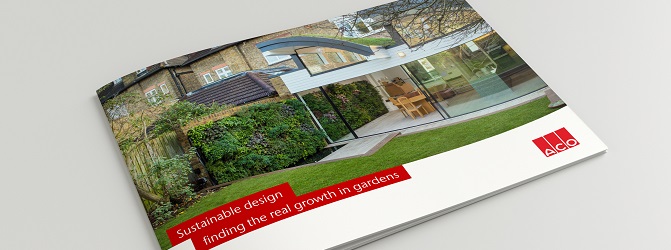
New sustainable garden design ebook
We have a new free ebook for garden designers and landscapers focusing on how sustainable design can be good for your customers, your business and ultimately the planet.
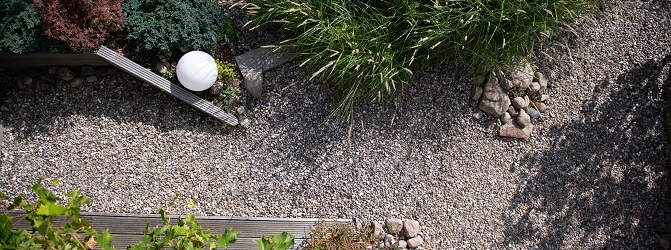
Making sustainable attainable – 10 simple ways to eco-friendly garden design.
Just a little patch of garden – that’s often all we need as human beings. Somewhere to grow one or two plants, attract a few bees and generally give us a sense of wellbeing. But one thing has made those outdoor spaces not only important for our welfare, but vital for the future of the planet – climate change.
So here, we’re sharing ten ways for you to build a little more sustainability into your next landscaping or garden design project.
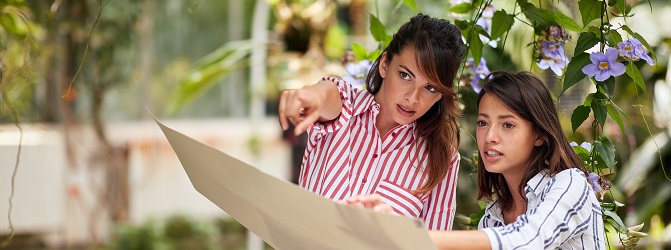
Garden designers and landscapers we have a page just for you
If you want tips and inspiration from world leading garden designers, and inspiration of how to handle changing customer needs.
